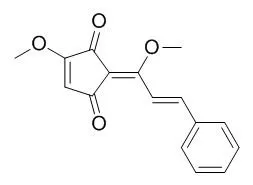| In vitro: |
| Eur J Pharmacol. 2012 Sep 5;690(1-3):4-12. | | Neuroprotective effect of methyl lucidone against microglia-mediated neurotoxicity.[Pubmed: 22683871] | The microglial regulatory mechanism of Methyllucidone, a cyclopentenedione isolated from the stem bark of Lindera erythrocarpa Makino, was investigated in the present study.
METHODS AND RESULTS:
Methyllucidone treatment (0.1-10 μM) significantly inhibited lipopolysaccharide (LPS, 100 ng/ml, 24 h)-stimulated nitric oxide (NO) production in a dose-dependent manner in both primary cortical microglia and BV-2 cell line. Moreover, it strongly inhibited LPS-stimulated secretion of pro-inflammatory cytokines, such as interleukin 6 (IL-6) and tumor necrosis factor α (TNF-α). Methyllucidone treatment markedly induced down-regulation of LPS-induced nuclear translocation of nuclear factor κB (NF-κB) through preventing the degradation of the inhibitory protein IκBα. In addition, phosphorylation of Akt and mitogen-activated protein kinases (MAPKs) such as extracellular signal-regulated kinase (ERK) and p38 kinases were also suppressed by Methyllucidone. The cell viabilities of HT-22 neurons were significantly attenuated by treatment of the conditioned media containing neurotoxic secretary molecules from LPS-stimulated microglia. However, Methyllucidone significantly blocked neuronal cell death induced by microglial conditioned media. These neuroprotective effects of Methyllucidone were also confirmed in a neuron-microglia co-culture system using EGFP-transfected B35 neuroblastoma cell line.
CONCLUSIONS:
Taken together, these results suggest that Methyllucidone may have a neuroprotective potential via inhibition of neurotoxic microglial activation implicated in neurodegeneration. | | Bioorg Med Chem. 2005 Nov 15;13(22):6182-7. | | Cyclopentenediones, inhibitors of farnesyl protein transferase and anti-tumor compounds, isolated from the fruit of Lindera erythrocarpa Makino.[Pubmed: 16055336] | The microglial regulatory mechanism of Methyllucidone, a cyclopentenedione isolated from the stem bark of Lindera erythrocarpa Makino, was investigated in the present study.
METHODS AND RESULTS:
Methyllucidone treatment (0.1-10 μM) significantly inhibited lipopolysaccharide (LPS, 100 ng/ml, 24 h)-stimulated nitric oxide (NO) production in a dose-dependent manner in both primary cortical microglia and BV-2 cell line. Moreover, it strongly inhibited LPS-stimulated secretion of pro-inflammatory cytokines, such as interleukin 6 (IL-6) and tumor necrosis factor α (TNF-α). Methyllucidone treatment markedly induced down-regulation of LPS-induced nuclear translocation of nuclear factor κB (NF-κB) through preventing the degradation of the inhibitory protein IκBα. In addition, phosphorylation of Akt and mitogen-activated protein kinases (MAPKs) such as extracellular signal-regulated kinase (ERK) and p38 kinases were also suppressed by Methyllucidone. The cell viabilities of HT-22 neurons were significantly attenuated by treatment of the conditioned media containing neurotoxic secretary molecules from LPS-stimulated microglia. However, Methyllucidone significantly blocked neuronal cell death induced by microglial conditioned media. These neuroprotective effects of Methyllucidone were also confirmed in a neuron-microglia co-culture system using EGFP-transfected B35 neuroblastoma cell line.
CONCLUSIONS:
Taken together, these results suggest that Methyllucidone may have a neuroprotective potential via inhibition of neurotoxic microglial activation implicated in neurodegeneration. | | J.Korean Soc. Agr. Biotechnol., 2003,46(2):150-3. | | Isolation of Antifungal Active Compounds from the Leaves of Lindera erythrocarpa.[Reference: WebLink] |
METHODS AND RESULTS:
Methanol extract obtained from Lindera erythocarpa leaves was successively fractionated with n-hexane, ethylacetate, n-butanol, and . From ethylacetate fraction, an active fraction was isolated through repeated silica gel column chromatography and recrystallization, and was identified as a stereoisomer complex of Methyllucidone by MS and MMR analyses.
CONCLUSIONS:
The complex showed 85% antifungal activity at 50 against the disease wheat leaf rust. |
|






 Cell. 2018 Jan 11;172(1-2):249-261.e12. doi: 10.1016/j.cell.2017.12.019.IF=36.216(2019)
Cell. 2018 Jan 11;172(1-2):249-261.e12. doi: 10.1016/j.cell.2017.12.019.IF=36.216(2019) Cell Metab. 2020 Mar 3;31(3):534-548.e5. doi: 10.1016/j.cmet.2020.01.002.IF=22.415(2019)
Cell Metab. 2020 Mar 3;31(3):534-548.e5. doi: 10.1016/j.cmet.2020.01.002.IF=22.415(2019) Mol Cell. 2017 Nov 16;68(4):673-685.e6. doi: 10.1016/j.molcel.2017.10.022.IF=14.548(2019)
Mol Cell. 2017 Nov 16;68(4):673-685.e6. doi: 10.1016/j.molcel.2017.10.022.IF=14.548(2019)